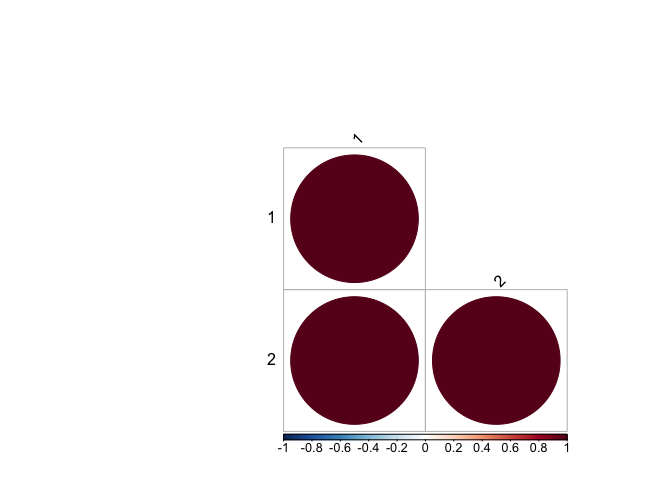Dear R-sudio community,
I am working with the workpachage rquery.cormat. By defaut, the correlation method is pearson (I guess), and I want to change because my data are not normal. So, as recommanded I add method = 'spearman', but it does not work. I have a error message telling my the arg should be one of "circle", "square", "ellipse", ...
Can you help me ?
Thanks,
Hi @VonaM. I check the code of rquery.cormat. It combine a number of functions. Your problem due the function called two functions cor.test and corrplot and both functions have method argument. So, you pass method = "spearman" to it for cor.test but function corrplot get the method argument wrongly. I add cor.method argument to cor.test and plot.method argument to corrplot to separate them and never use method argument which will cause error. You can run it by passing the cor.method = "spearman".
library(tidyverse)
rquery.cormat<-function(x, type=c('lower', 'upper', 'full', 'flatten'),
graph=TRUE, graphType=c("correlogram", "heatmap"),
col=NULL, cor.method = "pearson", plot.method = "circle", ...)
{
library(corrplot)
# Helper functions
#+++++++++++++++++
# Compute the matrix of correlation p-values
cor.pmat <- function(x, ...) {
mat <- as.matrix(x)
n <- ncol(mat)
p.mat<- matrix(NA, n, n)
diag(p.mat) <- 0
for (i in 1:(n - 1)) {
for (j in (i + 1):n) {
tmp <- cor.test(mat[, i], mat[, j], method = cor.method, ...)
p.mat[i, j] <- p.mat[j, i] <- tmp$p.value
}
}
colnames(p.mat) <- rownames(p.mat) <- colnames(mat)
p.mat
}
# Get lower triangle of the matrix
getLower.tri<-function(mat){
upper<-mat
upper[upper.tri(mat)]<-""
mat<-as.data.frame(upper)
mat
}
# Get upper triangle of the matrix
getUpper.tri<-function(mat){
lt<-mat
lt[lower.tri(mat)]<-""
mat<-as.data.frame(lt)
mat
}
# Get flatten matrix
flattenCorrMatrix <- function(cormat, pmat) {
ut <- upper.tri(cormat)
data.frame(
row = rownames(cormat)[row(cormat)[ut]],
column = rownames(cormat)[col(cormat)[ut]],
cor =(cormat)[ut],
p = pmat[ut]
)
}
# Define color
if (is.null(col)) {
col <- colorRampPalette(c("#67001F", "#B2182B", "#D6604D",
"#F4A582", "#FDDBC7", "#FFFFFF", "#D1E5F0", "#92C5DE",
"#4393C3", "#2166AC", "#053061"))(200)
col<-rev(col)
}
# Correlation matrix
cormat<-signif(cor(x, use = "complete.obs", ...),2)
pmat<-signif(cor.pmat(x, ...),2)
# Reorder correlation matrix
ord<-corrMatOrder(cormat, order="hclust")
cormat<-cormat[ord, ord]
pmat<-pmat[ord, ord]
# Replace correlation coeff by symbols
sym<-symnum(cormat, abbr.colnames=FALSE)
# Correlogram
if(graph & graphType[1]=="correlogram"){
corrplot(cormat, type=ifelse(type[1]=="flatten", "lower", type[1]),
tl.col="black", tl.srt=45,col=col, method = plot.method, ...)
}
else if(graphType[1]=="heatmap")
heatmap(cormat, col=col, symm=TRUE)
# Get lower/upper triangle
if(type[1]=="lower"){
cormat<-getLower.tri(cormat)
pmat<-getLower.tri(pmat)
}
else if(type[1]=="upper"){
cormat<-getUpper.tri(cormat)
pmat<-getUpper.tri(pmat)
sym=t(sym)
}
else if(type[1]=="flatten"){
cormat<-flattenCorrMatrix(cormat, pmat)
pmat=NULL
sym=NULL
}
list(r=cormat, p=pmat, sym=sym)
}
1:10 %>%
matrix(ncol = 2) %>%
rquery.cormat(cor.method = "spearman", plot.method = "circle")
#> corrplot 0.84 loaded

#> $r
#> V1 V2
#> 1 1
#> 2 1 1
#>
#> $p
#> V1 V2
#> 1 0
#> 2 0.017 0
#>
#> $sym
#>
#> [1,] 1
#> [2,] 1 1
#> attr(,"legend")
#> [1] 0 ' ' 0.3 '.' 0.6 ',' 0.8 '+' 0.9 '*' 0.95 'B' 1
Created on 2019-10-24 by the reprex package (v0.3.0)
This topic was automatically closed 21 days after the last reply. New replies are no longer allowed.